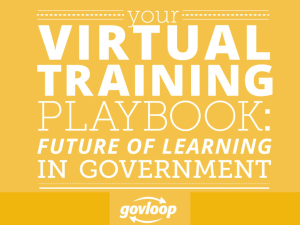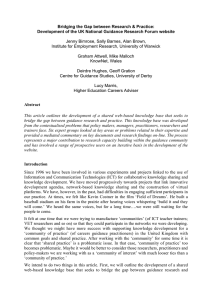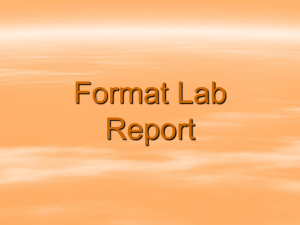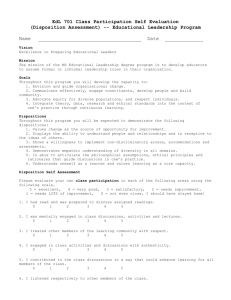B U L L E T I N
advertisement
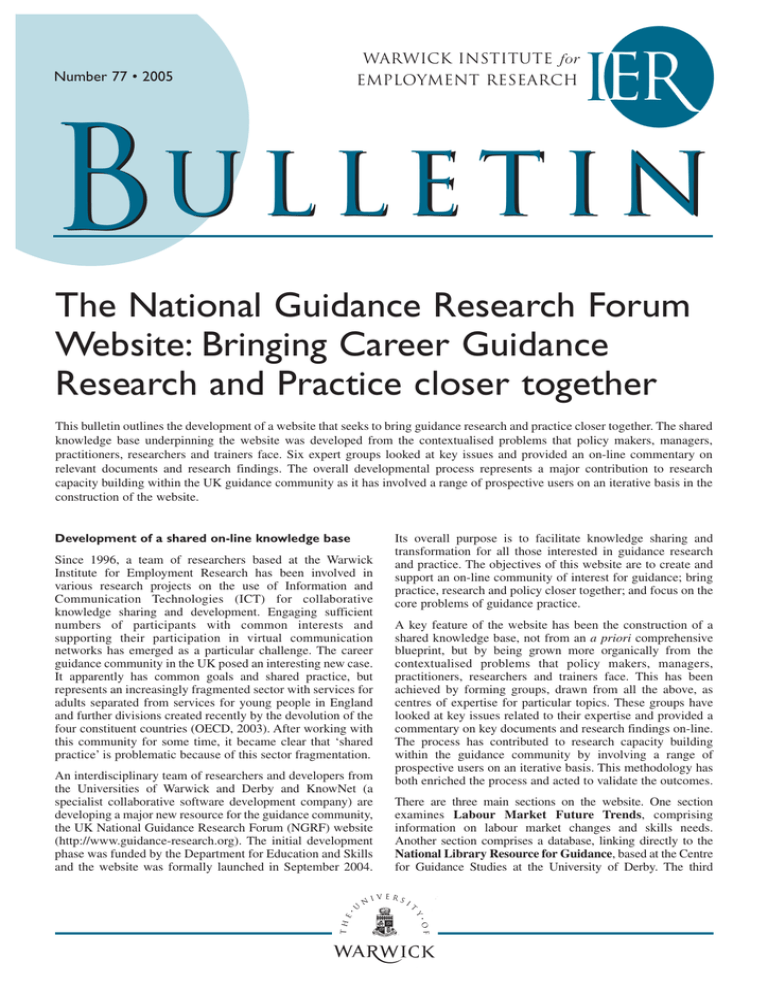
Number 77 • 2005 WARWICK INSTITUTE for EMPLOYMENT RESEARCH BU L L E T I N The National Guidance Research Forum Website: Bringing Career Guidance Research and Practice closer together This bulletin outlines the development of a website that seeks to bring guidance research and practice closer together. The shared knowledge base underpinning the website was developed from the contextualised problems that policy makers, managers, practitioners, researchers and trainers face. Six expert groups looked at key issues and provided an on-line commentary on relevant documents and research findings. The overall developmental process represents a major contribution to research capacity building within the UK guidance community as it has involved a range of prospective users on an iterative basis in the construction of the website. Development of a shared on-line knowledge base Since 1996, a team of researchers based at the Warwick Institute for Employment Research has been involved in various research projects on the use of Information and Communication Technologies (ICT) for collaborative knowledge sharing and development. Engaging sufficient numbers of participants with common interests and supporting their participation in virtual communication networks has emerged as a particular challenge. The career guidance community in the UK posed an interesting new case. It apparently has common goals and shared practice, but represents an increasingly fragmented sector with services for adults separated from services for young people in England and further divisions created recently by the devolution of the four constituent countries (OECD, 2003). After working with this community for some time, it became clear that ‘shared practice’ is problematic because of this sector fragmentation. An interdisciplinary team of researchers and developers from the Universities of Warwick and Derby and KnowNet (a specialist collaborative software development company) are developing a major new resource for the guidance community, the UK National Guidance Research Forum (NGRF) website (http://www.guidance-research.org). The initial development phase was funded by the Department for Education and Skills and the website was formally launched in September 2004. Its overall purpose is to facilitate knowledge sharing and transformation for all those interested in guidance research and practice. The objectives of this website are to create and support an on-line community of interest for guidance; bring practice, research and policy closer together; and focus on the core problems of guidance practice. A key feature of the website has been the construction of a shared knowledge base, not from an a priori comprehensive blueprint, but by being grown more organically from the contextualised problems that policy makers, managers, practitioners, researchers and trainers face. This has been achieved by forming groups, drawn from all the above, as centres of expertise for particular topics. These groups have looked at key issues related to their expertise and provided a commentary on key documents and research findings on-line. The process has contributed to research capacity building within the guidance community by involving a range of prospective users on an iterative basis. This methodology has both enriched the process and acted to validate the outcomes. There are three main sections on the website. One section examines Labour Market Future Trends, comprising information on labour market changes and skills needs. Another section comprises a database, linking directly to the National Library Resource for Guidance, based at the Centre for Guidance Studies at the University of Derby. The third 2 section, Making Guidance More Effective, contains a range of synopses, links, resources and edited discussions on six inter-related themes: ● ● ● ● ● ● Equal Opportunities (where some complex issues surrounding equality of opportunity and guidance are explored, together with relevant legislation); Impact Analysis (comprising research resources and discussions related to the impact of guidance); Using Research in Practice (combining an introduction to research processes with resources aimed at both newcomers and experienced researchers); Improving Practice (focused both on the theory underpinning practice and the ways in which changes - to policy or in technology - can lead to the need to reexamine and possibly rethink practice); Lifelong Learning (where the inter-relationships between learning and guidance are explored); International Perspectives (where participants can learn from international developments and contribute to a wider debate on current issues). The project extends the use of ICT to support knowledge development for the dispersed guidance community through an interactive and collaborative approach to knowledge creation (Brown, Attwell and Bimrose, 2002). The formation of six thematic expert work groups meant it was possible to advance understanding through processes of knowledge development, where existing knowledge was combined with new insights to create new forms of contextualised knowledge. This approach underpinned the importance of having sufficient time and space for face-to-face interactions to facilitate socialisation into the community, active reflection, combination of new and existing knowledge, and for individuals to internalise different ideas (Nonaka and Konno, 1998). An important feature of the website development has been the combination of opportunities to meet and talk through issues, engage in development work and link to continuing on-line discussions that facilitated collaborative knowledge creation, where individuals learn to share their knowledge and create new knowledge together. Participants involved in the website development used on-line support that meant they were able to collaborate independent of time and space; participate in their own time and at their own pace; make contributions in different forms; or explore something thoroughly by commenting on material and contributing to discussions (and in so doing elaborate on the knowledge already on the website). The key to this process of knowledge development has been to set up a genuinely collaborative environment for a wide range of participants. The environment enabled participants to: (jointly) develop, edit and modify materials; share annotation on material; facilitate the sharing of experience; promote discussion, sharing and collaborate actively. This was achieved by offering virtual spaces for debate and collaboration; supporting action research; offering active support and moderation; offering support to particular interest groups; and providing a forum for discussion of attempts to tackle complex problems in careers guidance practice. Collaborative development processes Individuals from many organisations involved in guidance participated in the development process. They were drawn from careers companies; Information, Advice and Guidance partnerships; higher education; voluntary and community sector organisations; the private sector; various government organisations; and employers. Additionally, the project team engaged in continuing dialogue with representatives of organisations with a strategic interest in the development of career guidance policy and practice and/or the development of labour market information. By working together, participants used the collective and individual knowledge of group members in order to extend that knowledge (Scardamalia and Bereiter, 1994). It is important for participants to be able to influence the development process themselves through working together on-line and becoming used to sharing knowledge, deepening their own and common understanding and creating further insights. A model of progressive inquiry was therefore adopted that engaged participants in the development (in a step-by-step process) of question and explanation driven inquiry. These were called ‘team tasks’ and comprised a series of particular questions, grounded in practice, relating to one of the six broad themes described above. For example, in Impact Analysis a lively discussion ensued around “Much of quality assessment is to do with how systems operate with an emphasis on what the organisation does, procedures and paper trails, complaints, appointment procedures and so on. There could be an inbuilt danger that quality assessment tilts too far towards looking at organisational systems and practice at the expense of enquiry into the benefits to service users.” The results of this discussion, including exploration of the benefits quality standards bring to clients, can be seen on the website, framed by related discussions and linked to a wide range of other materials. The approach adopted for the website development added still greater support to the process of knowledge building by making continuing use of face-to-face sessions which focused around the interweaving of research and practice. Continuing collaboration The commitment of the project team to collaboration throughout the development process is central to how the site operates – supporting the community in an interactive way. For example, the processes of reflection, consolidation and community development are supported by presenting resources in a range of ways that are meaningful for the community at a particular time. Resources have also been allocated to supporting active discussions, by organising material to support discussions and establish links between current or past discussion topics. Like the discussions that took place during the development phase, it is expected that new discussions will cross topic or subject boundaries, evolve and change shape over time. This ‘organic growth’ of discussions will continue to be supported. For the site to be most useful to both practitioners and researchers, participants need to be encouraged to be more explicit about their purposes and desired outcomes. 3 Ideally, users of the site will eventually play oracle to each other - posing questions and receiving useful answers. This is central to the future purpose of the website. As well as supporting live discussions, extensive use of discussion summaries has been made, with active editing of material by members of the project team. After discussions are finished, they are deconstructed so that the separate points and strands can be placed in an appropriate context where they can be framed by supporting material (with copies of the full, original discussion archived). Adding value to key documents over time is also a goal. For example, the project team received requests for help in learning how to undertake research from a number of practitioners. Whilst the website already has useful support materials for this, it could be rendered even more useful if examples were added of how users managed when they tried to put these ideas into practice, together with a record of discussion on this topic. Finally, the website also provides a link to the related development of the National Library Resource for Guidance (NLRG) based at Centre for Guidance Studies, University of Derby. This library holds the UK’s largest collection of guidance literature. The NLRG supports the work of the website both by providing access to annotated materials to support discussion and research, as well as providing an archive for completed discussion strands. Lessons learned from the development of the website Until now, the use of ICT to support knowledge sharing and development has often failed to deliver the promised benefits. Whilst email is widely used and the web spawns technical, academic and leisure bulletin boards, websites and list servers, there is still a marked lack of collaborative knowledge development. What spaces there are for sharing knowledge tend to be used as collective file repositories or areas for shorter discussions. There are, of course, exceptions. Technical and software developers use the Internet as a means for co-development of software, especially in the growing Open Source Software Community. The public Human Genome project was largely made possible through intense networked collaboration using computer-based communication. Yet, these seem to be exceptions that prove the rule. The constraints of daily work and research practice mean networked collaboration - even amongst those involved in dispersed communities and engaged in common international projects - is limited. Software development though is dynamic with new developments appearing all the time. It is possible that the software industry will produce a ‘killer application’ for knowledge sharing. The recent upsurge in web logs (blogs) is an interesting example where, whilst not invented for knowledge development, there are signs of their use in sharing knowledge. The NGRF website is experimenting with their use too. identification, however, may not be strong. They have fairly loose ties. Indeed, perhaps one reason why people may value a ‘community of interest’ in this area is that the ‘community of practice’ (Lave and Wenger, 1991) associated with careers guidance in the UK is fragmenting.1 Maybe some people involved would like at least to be able to construct a ‘shared story’ about what is happening in their professional field. ‘Our community’ therefore has interests in learning but their practices are diverse, whereas with a community of practice you would expect a much stronger sense of mutual engagement, joint enterprise and sharing of goals with a common repertoire of shared practices. Professional development The intention of the website is to support professional development that is based around research and practice grounded in the questions, concerns and enquiries of practitioners. The aim is, therefore, shared development. There is a role for coaching, mentoring, observation by colleagues (knowledgeable others) and examples of how practitioners can engage with research. For example, a journal article could be annotated to help practitioners ‘break the research code’ and show how to make judgements about the conclusions. There could also be value in collaboration on problem-oriented case-work (working on interpretations of a ‘shared case’). A final issue relates to how to resolve emotional tensions arising from an inability to perform in the way you think is appropriate (for example, if you are not resourced to offer the quality of service possible). Knowledge-building perspectives Knowledge combination remains the key challenge. In distributed computer-mediated discourses conversations can often dwindle, so the ‘knowledge spaces’ for our ‘community of interest’ are supported so that they can contribute to the public life of ideas. For example, the development ideas for a research project could be outlined as a way of representing the research process as peer review through the public disclosure of plans. A few members of the community could work on their ideas in a public space, but then the wider community may benefit through seeing the process in action. The interlinking of discourses, and the facilitation of different ‘views’ of material, can help build (or highlight the disjunctions in) coherence, comprehensiveness and links between theory and practice within and between different areas. The use of summaries, syntheses, reflections and annotations in the heavily mediated environment of the NGRF website can help with the transition between (to adapt Donald Schön’s [1983] analogy) the cliff-top of critical analysis and the swamp of everyday practice. Careers advisers and personal advisers (offering a range of advice to young people at risk of social exclusion) now have different knowledge domains. It is unclear where the boundaries lie between different types of practitioners involved in giving Information, Advice and Guidance in different settings – are the boundaries clear, fuzzy or contested? How far do they share at least some domains of knowledge? Also, since devolution, the four constituent parts of the UK are now following very different agendas as to how they deliver careers guidance. 1 Community of interest In this particular context, those interested in careers guidance research and practice could best be described as a ‘community of interest’: a group interested in sharing a discourse; sharing thinking; and sharing values to some degree. Group 4 One of the difficulties encountered by successful knowledgebuilding approaches is how ideas and contributions, together with the space they take and the time to search them, starts to increase rapidly. Hence it is important that representations show relationships between topics and that these representations are to some degree under the control of participants. The practitioner-researcher interactions on the website have also been linked to the wider concerns of the ‘community of interest’. The importance of supporting knowledge-building has been recognised and the website developers have sought to create models and cluster viewpoints so as to overcome the problems of isolated contributions. The site can be seen as a representation of the stage that the ‘community of interest’ as a whole has now reached. Knowledge-building involves learning: how to find different types of knowledge; and how to learn together, with collective responsibility for developing expertise and conceptual ideas. Computer-supported collaborative learning Lessons learned about how computer-supported collaborative learning, which can help bring guidance research and practice closer together, include: ● ● ● ● ● ● ● ● ● ● ● ● ● ● there is a need for thoughtful mediation of contributions and discussions; recognition that work-related learning may figure behind other aspects of private lives and working lives; the relative failure of ‘big ideas’ for development and collaboration may be because they are crowded out by lots of smaller but more immediate ideas and concerns; the goals behind producing explanations, summaries, solving problems etc. should be made explicit; the value of prompts for comments and guided questioning (‘what is the difference between…’; ‘how does this work in practice…’); activities can be clustered to support collaboration; it may be useful to represent the same information in different ways; problems may arise due to a loss of motivation; a loss of coordination or because of a lack of feelings of co-presence; the recognition that making contributions to discussions can feel rather demanding and exposing; there could be a number of bases for common ground in a ‘community of interest’: shared understandings; shared meanings; shared opinions; and shared positions; participants are more likely to contribute if they have an awareness of process and what others are doing; how shared knowledge can build in common misconceptions; often general lessons cannot be abstracted from the complexity, context and goals of particular situations; collective meaning making may lead to development of certain ‘voices’ which may depress other voices - we all have different voices in different contexts; ● ● inter-textual links (where different voices meet) are rich in terms of justifications, meeting of different discourses, explanations varied according to context etc.; and individuals were seeking direction, making meaning and establishing roles for themselves in their contributions over time. Conclusion This bulletin2 has presented ideas drawn from the practice of, and research into, the development of knowledge in communities of interest. To progress further, two types of support are required from within the guidance community. The first is for a greater commitment to the integration of research findings with practice, together with increased capacity and expertise in the use of ICT. Second, the processes of software design for projects and research into knowledge development need to be more collaborative. Iterative and co-design of software applications and programs require participatory design processes with informed reflections on those processes. This initiative represents an exciting opportunity to create an inclusive and dynamic community of interest bringing guidance research and practice closer together. It will increase our understanding of how learning about guidance is created and shared (covering beliefs, concepts, ideas, theories, actions) as well as providing a potentially powerful engine to assist the search for new understandings of effective guidance to benefit all clients. Please join us in our endeavour and visit: http://www.guidance-research.org. References Brown, A. Attwell, G. and Bimrose, J. (2002) Utilising Information and Communication Technologies for dispersed communities of practice, in Lally, V. and McConnell, D. (eds) Networked collaborative learning, Sheffield: School of Education, University of Sheffield. Lave, J. and Wenger, E. (1991) Situated Learning. Legitimate peripheral participation, Cambridge: University of Cambridge Press. Nonaka, I. and Konno, N. (1998) The Concept of “Ba”: Building a Foundation for Knowledge Creation, California Management Review, 40, 3, 40-54. Scardamalia, M. and Bereiter, C. (1994) Computer support for knowledge-building communities, Journal of the Learning Sciences, 3, 3, 265 –28. Schön, D. (1983) The Reflective Practitioner. How professionals think in action, London: Temple Smith. This bulletin was prepared by the IER NGRF website development team Jenny Bimrose, Sally-Anne Barnes and Alan Brown. For further information please e-mail j.bimrose@warwick.ac.uk or visit the website at: http://www.guidance-research.org. For information about related IER work see the IER website: www.warwick.ac.uk/IER. 2
